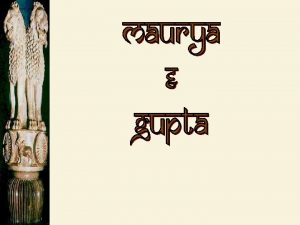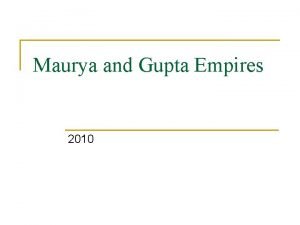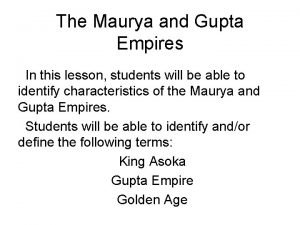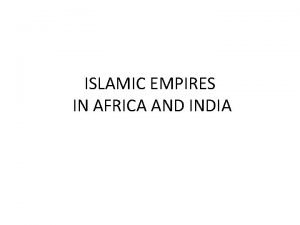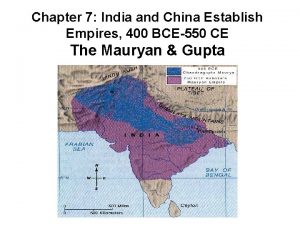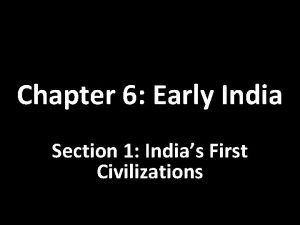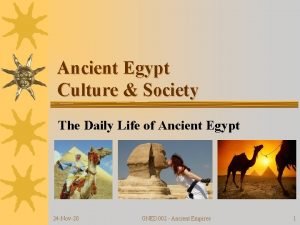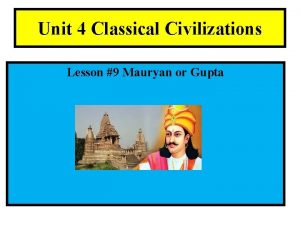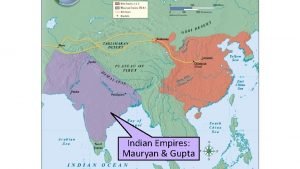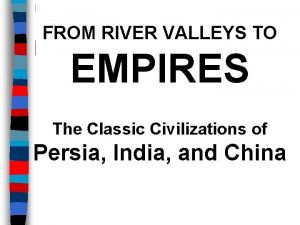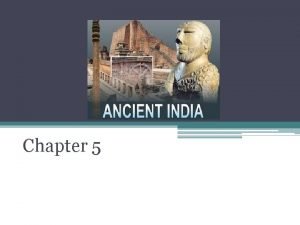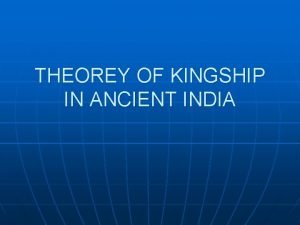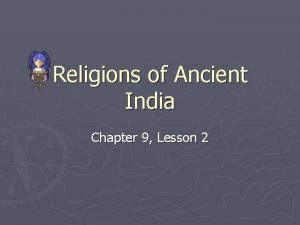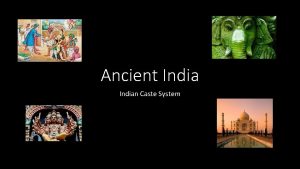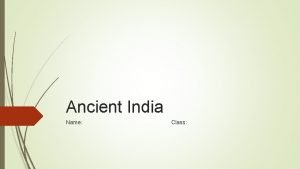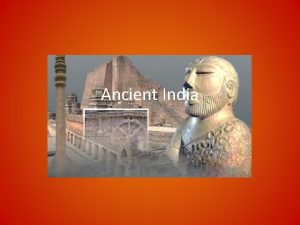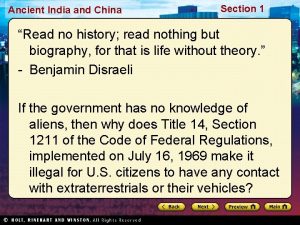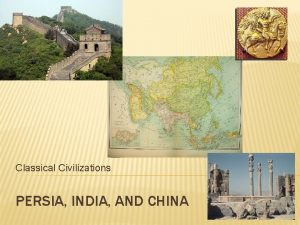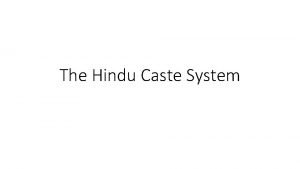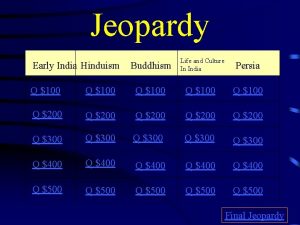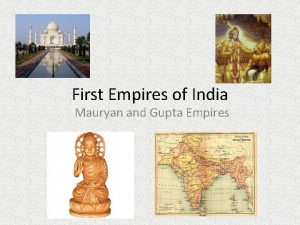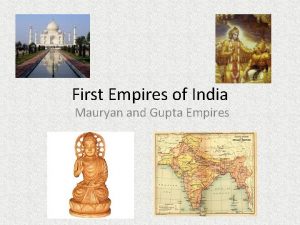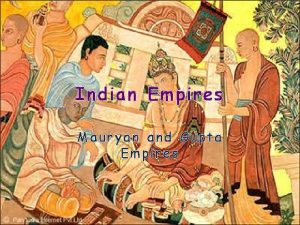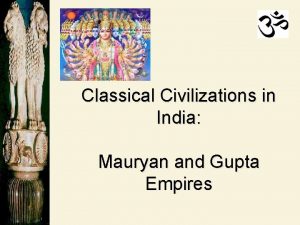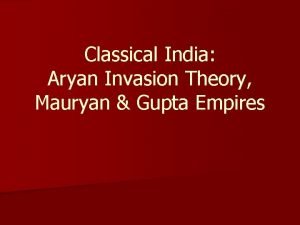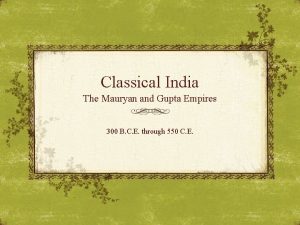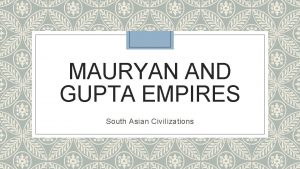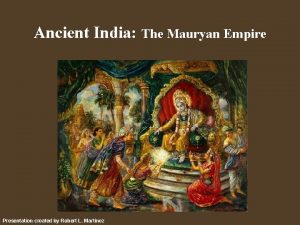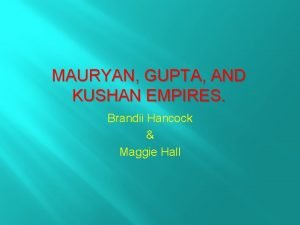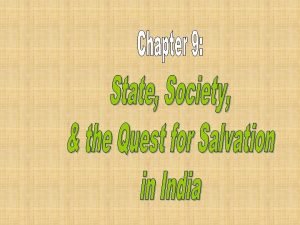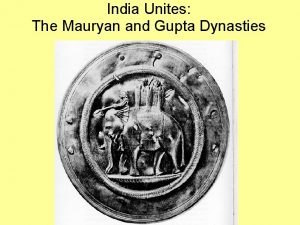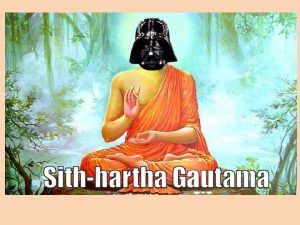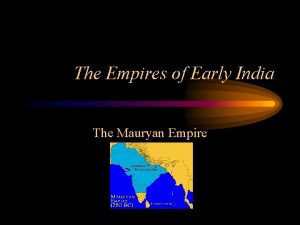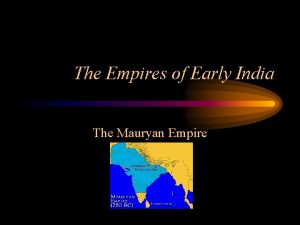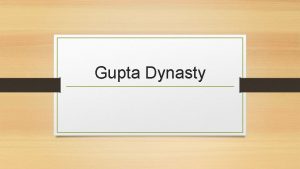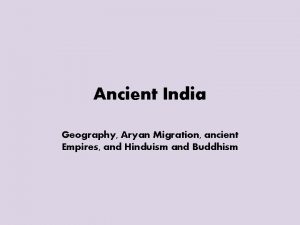Ancient India The Mauryan Gupta Empires Presentation created
































- Slides: 32

Ancient India: The Mauryan & Gupta Empires Presentation created by Robert L. Martinez

Around 330 B. C. E. , Alexander the Great conquered the Persian Empire and continued into India.

During this time, the Aryan culture and belief systems continued to spread throughout India.

Then, around 321 B. C. E. , a new empire arose in India, one that would come to be the largest in that country to date.

Spanning from the Indus River Valley eastward through the Ganges River Valley and southward through the Deccan Plateau …

… the Mauryan Empire was founded by Chandragupta Maurya, who unified the smaller Aryan kingdoms into a civilization.

Chandragupta: 321 BCE-298 BCE § Unified northern India. § Defeated the Persian general Seleucus. § Divided his empire into provinces, then districts for tax assessments and law enforcement. § He feared assassination [like Saddam Hussein] food tasters, slept in different rooms, etc. § 301 BCE gave up his throne & became a Jain (ascetic Buddhist)

Kautilya § Chandragupta’s advisor. § Brahmin caste. § Wrote The Treatise on Material Gain or the Arthashastra. § A guide for the king and his ministers: Ø Supports royal power. Ø The great evil in society isanarchy. Ø Therefore, a single authority is needed to employ force when necessary!

The Maurya Empire 321 BCE – 185 BCE

But it would be his grandson, Ashoka Maurya, who would take the empire to its greatest heights.

Asoka’s Empire

Asoka (304 – 232 BCE) § Religious conversion after the gruesome battle of. Kalinga in 262 BCE. § Dedicated his life to Buddhism. § Built extensive roads. § Conflict how to balance Kautilya’s methods of keeping power and Buddha’s demands to become a selfless person?

For the rest of his reign, Ashoka preached nonviolence and moderation.

Ashoka is also known for his Rock and Pillar Edicts, which were carved on rocks and pillars throughout the empire.

These edicts reminded Mauryans to live generous and righteous lives.

Asoka’s law code § Edicts scattered in more than 30 places in India, Nepal, Pakistan, & Afghanistan. § Written mostly in Sanskrit, but one was in Greek and Aramaic. § 10 rock edicts. § Each pillar [stupa ] is 40’-50’ high. § Buddhist principles dominate his laws.

One of Asoka’s Stupas

Following Ashoka’s conversion and commitment to Buddhism, the religion spread beyond India into many parts of Southeast Asia.

Turmoil & a power Vacuum: 220 BCE – 320 CE Ta mi ls The Maurya Empire is divided into many kingdoms.

Gupta Empire: 320 CE – 647 CE

Gupta Rulers § Chandra Gupta I v r. 320 – 335 CE v “Great King of Kings” § Chandra Gupta II v r. 375 - 415 CE v Profitable trade with the Mediterranean world! § Hindu revival. § Huns invade – 450 CE

Fa-Hsien: Life in Gupta India § Chinese Buddhist monk traveled along the Silk Road and visited India about 400 CE. § He was following the path of the Buddha. § He reported the people to be happy, relatively free of government oppression, and inclined towards courtesy and charity. Other references in the journal, however, indicate that the caste system was rapidly assuming its basic features, including "untouchability, " the social isolation of a lowest class that is doomed to menial labor.

Chandra Gupta 11

Kalidasa § The greatest of Indian poets. § His most famous play was. Shakuntala. § During the reign of Chandra Gupta II.

Gupta Art Greatly influenced Southeast Asian art & architecture.

500 healing plants identified 1000 diseases classified Printed medicinal guides Plastic Surgery Gupta Achievements Kalidasa Literature Medicine Inoculations Gupta India C-sections performed Decimal System Mathematics Concept of Zero PI = 3. 1416 Solar Calendar Astronomy The earth is round

The Decline of the Guptas § Invasion of the White Huns in the 4 c signaled the end of the Gupta Golden Age, even though at first, the Guptas defeated them. § After the decline of the Gupta empire, north India broke into a number of separate Hindu kingdoms and was not really unified again until the coming of the Muslims in the 7 c. § QUESTION : Is the best literature and art written as the civilization is on the rise, at its height, or in its decline?

Bhartrhari § 5 c India court poet and philosopher. Knowledge is man's crowning mark, A treasure secretly buried, The source of luxury, fame, and bliss, A guru most venerable, A friend on foreign journeys, The pinnacle of divinity. Knowledge is valued by kings beyond wealth--When he lacks it, a man is a brute.

A major reason that the Mauryan Empire became so powerful and wealthy was trade.

Indians merchants traded in silk, cotton, and elephants (among hundreds of other things) to Mesopotamia and the eastern Roman Empire.

International Trade Routes during the Guptas

Extensive Trade: 4 c sp ic es rice & whea horses t vory i & gold ods o g on cott s silk ods o g on cottspices gold & ivory
 Venn diagram of mauryan and gupta empires
Venn diagram of mauryan and gupta empires Chandragupta maurya ruled for _____years.
Chandragupta maurya ruled for _____years. Difference between maritime and land based empires
Difference between maritime and land based empires The maurya and gupta empires
The maurya and gupta empires The maurya and gupta empires
The maurya and gupta empires Indias first empire
Indias first empire Ancient india vs ancient china
Ancient india vs ancient china India empires
India empires India's first empire
India's first empire Chapter 7 india and china establish empires
Chapter 7 india and china establish empires Chapter 7 section 1 india's first empires
Chapter 7 section 1 india's first empires Early empires in the ancient near east
Early empires in the ancient near east Ancient empires jar
Ancient empires jar Mauryan empire
Mauryan empire The mauryan empire
The mauryan empire Why mauryan empire decline
Why mauryan empire decline Mauryan people
Mauryan people How did the mauryan empire’s army help to promote trade?
How did the mauryan empire’s army help to promote trade? Mauryan empire mind map
Mauryan empire mind map Theory of kingship in ancient india
Theory of kingship in ancient india Lesson 2 religions of ancient india
Lesson 2 religions of ancient india Chapter 9 lesson 1 early civilizations
Chapter 9 lesson 1 early civilizations Indian caste system pyramid
Indian caste system pyramid Mr. nicky ancient india
Mr. nicky ancient india Indian social classes
Indian social classes Jobs in ancient india
Jobs in ancient india What is it
What is it Egypt medicine
Egypt medicine Social structure in india
Social structure in india Ancient india natural resources
Ancient india natural resources Ancient india jeopardy
Ancient india jeopardy Which experience led to a deep change in ashoka's values
Which experience led to a deep change in ashoka's values Pictures of ancient and modern means of communication
Pictures of ancient and modern means of communication
